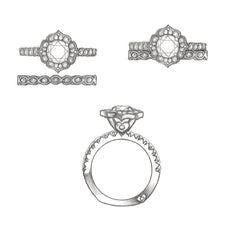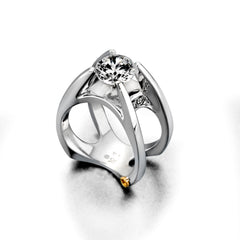How To Match A Wedding Band To An Engagement Ring
Match Made in Heaven: Engagement Rings and Wedding Bands
You were surprised with the perfect engagement ring, or maybe you picked it out yourself and couldn’t be happier. Engagement ring: check!
But even once the diamond is secure upon your finger, ring shopping has only just begun. When it comes to matching wedding bands and engagement rings, you may feel overwhelmed by options. Or perhaps the engagement ring has a matching band that isn’t to your liking.
As couples embark on this journey together, the process of selecting the perfect wedding band to complement the engagement ring becomes a significant choice, given that you’ll both be wearing these for the foreseeable future. Matching these two pieces requires careful consideration of metal and stone (if any) choice and design elements.
Whatever the circumstance, matching rings for the big day just got a whole lot simpler–thanks to this article.
Before we talk about matching a wedding band to an engagement ring, it’s first necessary to make sure you understand your engagement ring. Examine the design, setting, stone(s), and overall style. Is the engagement ring set with a solitaire diamond, a cluster of colored gemstones, or a halo setting? Is it set in white gold, rose gold, yellow gold, or platinum? By understanding these aspects, you can identify key features to consider when choosing a complementary wedding band.
Here are the six key factors to consider when deciding how to match a wedding band to an engagement ring:
Matching Metals
Selecting the right metal for both the engagement ring and wedding band is crucial to achieving a harmonious match. This “rule” may seem obvious, but it’s really not–because there is no rule! Mixing metals can create a visually appealing contrast, but it's essential that they complement each other. Just because your engagement ring is platinum doesn’t mean your band has to be as well. You can mix and match metals to create a unique look. White gold and yellow gold, rose gold and white gold, or whichever combination strikes your fancy. Or if you prefer that your engagement ring and wedding band are the same color metal, go for it. After all, there is no rule!

Beware of Spaces
When wearing an engagement ring and wedding band, the goal is for the two rings to look as if they belong together. The number one way rings can look mismatched is if there is a gap between the two bands. Because of diamond placement, design and numerous other details, it’s common for engagement rings to extend past the band. In order to avoid this potential pitfall, work with your jeweler to design a wedding band that fits snugly against the engagement ring. Gaps are common problems and jewelers are aware; so don’t panic if your wedding band requires some special attention.

Consider Overall Width
When considering the design of your wedding band, you’ll want to consider the width of your engagement ring and how wide you would like them to be when worn together. Most people choose to wear their wedding set of both rings on a daily basis, and you want to make sure that together they feel significant enough for your hand, but not too wide that it’s uncomfortable on your finger. A thin, delicate band might complement a dainty engagement ring, while a wider band can be more substantial when paired with a bolder engagement ring. It's important to strike the right balance between the two rings, ensuring that neither overwhelms the other.
Additionally, a contoured or curved wedding band can be designed to fit snugly against the engagement ring, enhancing both aesthetics and comfort.
Luckily, the majority of jewelers will have plenty of engagement ring options (with or without stones, wide vs. thin, etc.) for you to try on against your engagement ring before making any decisions. This will allow you to make the best choice before committing to such an important decision.

Be Aware of Symmetry (or Asymmetry)
Who says your wedding set needs to be symmetrical? Not us! While a symmetrical set can be absolutely beautiful, there’s certainly nothing wrong with something that feels a little “off balance” in just the right way. If you do want symmetry, you can focus on the specific design aspects of your engagement ring. If your engagement ring has intricate detailing such as engraving, milgrain, or filigree, consider selecting a wedding band with similar design elements. This could create a greater sense of unity between the two rings. If you're aiming for an asymmetrical look, refer back to the metal choice section above. You can also opt for choosing angles on your band that make the overall look of the set together asymmetrical. Think about selecting different stones (see below for more information).
Gemstone Choices
There’s no proper way to match the presence or absence of stones on your engagement ring to your wedding band. If you have a solitaire engagement ring, a solid gold band would look beautiful, but so would a diamond (or gemstone) band. If your engagement ring features colored gemstones, your wedding band can also contain that same gemstone, or diamonds, or a combination of the two. Essentially, there is no right or wrong choice. This decision comes down to your personal desires. To make this easier, consider if you only want diamonds in your ring(s), or–if you desire gemstones–what color combinations you like. Then you can consider which gemstones come in the colors that you prefer and design your band around those options.
You should also consider the hardness of a gemstone when designing your ring, as you wouldn’t want to choose a stone that is too soft and more prone to chipping or cracking. These rings will be subjected to daily wear, so the harder the accent stones, the more chances that it will last the test of time. (For more information, refer to the Mohs scale of hardness.)

It’s also important to think about stone shape. If your engagement ring features a round diamond, there’s no rule stating that your wedding band has to also feature round diamonds. Take a look at all the diamond shape options and consider which ones you like and which ones would nicely complement the stone in your engagement ring.
Details, Details, Details
Every engagement ring is unique, and because of that, wedding bands are starting to follow suit. Purchasing wedding bands not originally intended for a particular engagement ring is a fast growing trend. For vintage rings, pick a band that highlights your favorite part of the ring. If your engagement ring has a particularly ornate or show-stopping design, feel free to skip the wedding band altogether and merely use your engagement ring at the ceremony. Modern rings look best with modern style bands. Think sleek and minimal when shopping.

Most importantly, feel free to think beyond the expected and always choose the ring that speaks to your heart.
Ultimately, the most important consideration when matching a wedding band to an engagement ring is personal expression.
The rings you choose as a couple should reflect your style and relationship. Don't be afraid to do your research, be creative and ask plenty of questions. Jewelers who specialize in custom design will be honored to make you the wedding band of your dreams, and there are endless customization options. If your jeweler only offers "off-the-shelf" options, with no customization possible, you may want to reconsider your jeweler.
Don’t forget to ask your jeweler about a special engraving on the inside of your ring, such as your wedding date, your initials, etc.

